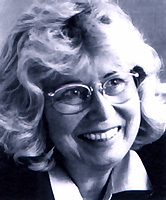CHARLOTTE KOLLMORGEN - OBSERVATIONS ON THE WORK OF A PAINTER
By Prof. Dr. Johannes Eucker, Hochschule der Künste, Berlin
Page 2
Painting as a medium, colour as the means to an artistic end.
Anyone who paints needs - or will develop over time - a painting concept. This concept evolves from certain artistic decisions. Charlotte Kollmorgen has taken such decisions.
First of all, there is her decision in favour of oil paints as a technical means. Her large format pictures are painted not with tempera nor with acrylic paints. What benefits do oil paints have, what possibilities do they offer?
It is well-known that rich colour tones can be produced with oils. The artist makes full use of this material property. In terms of painting technique oil colours also offer an advantage: You can change them on the support or grounding during painting. You can apply them as a glaze, i.e. in several transparent layers of paint one on top the other. You can apply them on the canvas with the canvas knife and impasto (Greek for thick paste). And they can be squeezed directly from the tube onto the canvas as modern artists have demonstrated.
The second feature of Charlotte Kollmorgen’s painting concept is her interpretation of painting as a means of artistic expression. In his ‘Fundamentals of Art History’ the art historian Heinrich Wölfflin stipulated the polarity between the linear and the picturesque in painting. That the view of something, say a landscape, is ‘picturesque’ is also a frequently used term in everyday language. Yet, in painting all things can be interpreted in two different ways. You can see them either more in terms of their contours or shapes or more in terms of their patches and blurs, i.e. their colours. The former is the classic (drawing-type) perception, the latter the picturesque atmosphere.
This painting concept adopted by the artist influences the perception of the recipients. Yet, the recipients learn to see not only art in this way but they can also transfer their newly acquired perception of art to the perception of the world around them.
The beholders may adopt the artist’s way of seeing the world (at least experimentally) and keep it for good if appropriate. Charlotte Kollmorgen’s paintings can also stimulate beholders to change their view of the world. Her work is an offer to our perception, an invitation to see things in a more differentiated way.
If it is possible to distinguish between a more picturesque and a more drawing-type kind of painting what then are the characteristics of Charlotte Kollmorgen’s work?
Reviewing her works one finds that there is a strong trend towards the linear. Colour is used very graphically, but not exclusively so. It is her simultaneously graphic and picturesque use of colour that characterizes her work. In fact, she reconciles the two painting concepts. And beholders may be reminded of Kandinsky who expressed the view that graphics and painting were not really ‘two different art forms’ (Kandinsky in his book ‘From Point and Line to Area’, p. 33). There was no ‘intrinsic (in italics in the original, J.E.) reason’ for this distinction. In some of Charlotte Kollmorgen’s works areas and lines play with and against each other thus constituting the very composition of the painting. In others, lines emphatically team up with lines to form areas or configurations to be interpreted spatially. Does this simultaneous use of colour as a graphic and a picturesque device reflect the artist’s career development, her work as a graphic designer?
|

